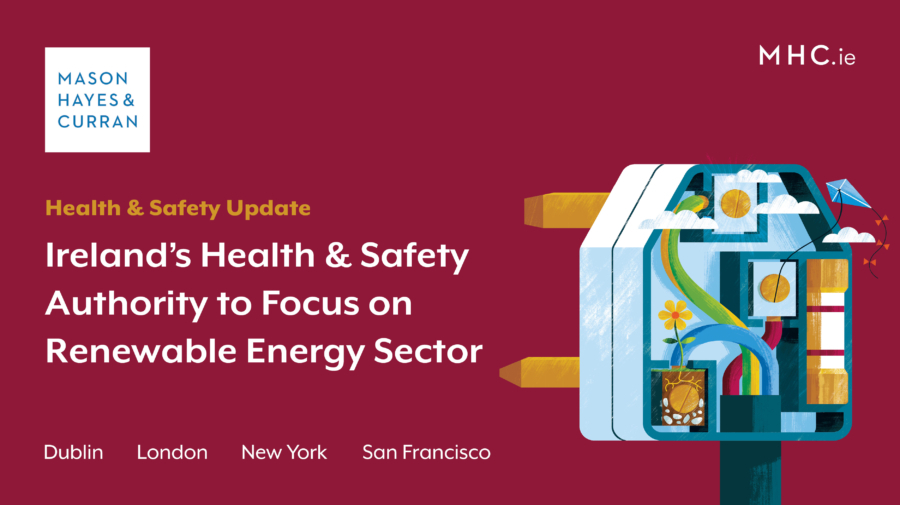Ireland’s Health & Safety Authority to Focus on Renewable Energy Sector

Ireland’s Health and Safety Authority has started an inspection campaign targeting the renewable energy industry. The HSA will carry out inspections to ensure companies are compliant with their health and safety obligations. This will include inspections of wind farms, solar farms and anaerobic digestion facilities. Our Health & Safety team looks at the implications for those in the renewables sector.
The Health and Safety Authority (HSA) has started a campaign aimed at ensuring renewable energy industry operators are compliant with their health and safety obligations. This intensified focus likely stems from the ongoing rapid expansion of the renewables industry in Ireland. This is the first inspection campaign of its kind to be carried out by the HSA. It is expected that wind farms, solar farms and anaerobic digestion facilities will be high on the inspectors’ list of targets. We briefly review the key hazards that inspectors will be looking out for and what operators should do to reduce the risk of enforcement action being taken against them.
Health and safety legislation ought to be at the forefront of employers’ policies. This is of course to ensure the safety of workers, but also because both companies and their directors can be held liable for breaches of health and safety legislation. Directors may be held personally liable where a company breaches health and safety legislation and the directors are deemed to have authorised, consented to, or otherwise attributed to the breach. Recently, a company has been fined €750,000 regarding a ‘fall from height’ accident. Another employer has been imprisoned for 12 months for failing to have safe working practices in place. Both breaches led to the unfortunate fatality of workers. It is important, therefore, that renewable energy operators ensure they are compliant with the law and are prepared for a HSA inspection.
Key hazards
As part of the inspection campaign, it is expected that HSA inspectors will focus on key hazards relevant to each type of renewable energy facility. These include:
- Excavations
- Lifting operations
- Working at height
- Electrical safety
- Gas safety, and
- Emergency response plans
However, this is a non-exhaustive list and operators are obliged under the Safety, Health and Welfare at Work Act 2005 to carry out risk assessments of their specific operations and places of work to identify the key hazards relevant to them.
Mandatory and recommended actions
It is the responsibility of facility owners and operators to ensure the safety, health and welfare of persons present at their facilities or on their sites. There are extra duties on employers to ensure the safety, health and welfare of their employees and other persons carrying out work on their behalf. This requires employers to implement safe working practices and provide a safe place of work. The duties of employers are expected to be the focus of the HSA’s campaign.
In addition to carrying out mandatory risk assessments, employers must ensure they implement safe working practices. Some examples of what employers must do to achieve this are:
- Prepare a Safety Statement based on identified risks and ensure all employees and other workers are aware of and understand its contents
- Make sure all work is properly planned, organised and carried out by a competent person
- Provide appropriate work equipment and personal protective equipment (PPE)
- Ensure employees and other workers comply with safety systems, and
- Provide appropriate training to employees on work practices such as manual handling, working at height, etc, and ensure training is kept up to date by providing formal training and toolbox talks
Again, this is a non-exhaustive list intended for illustrative purposes only. Employers must tailor their safety systems to their specific operations.
Continuing obligation
Facility operators should note that even though operational wind and solar farms require a relatively low amount of human input, they still qualify as “places of work” for the purpose of health and safety legislation. It is important not to overlook the implementation of safety systems to ensure employee safety during routine inspection and maintenance work.
Conclusion
While the HSA’s inspection campaign is considered to be unprecedented, it provides a timely reminder to facility operators and employers to ensure their safety systems are compliant. The renewable energy sector is exposed to specific hazards and risks that must be managed effectively to reduce the risk of accidents as well as liability for directors and companies.
Please contact a member of our Health & Safety team if you would like to discuss this area in further detail.
The content of this article is provided for information purposes only and does not constitute legal or other advice.
Share this:





